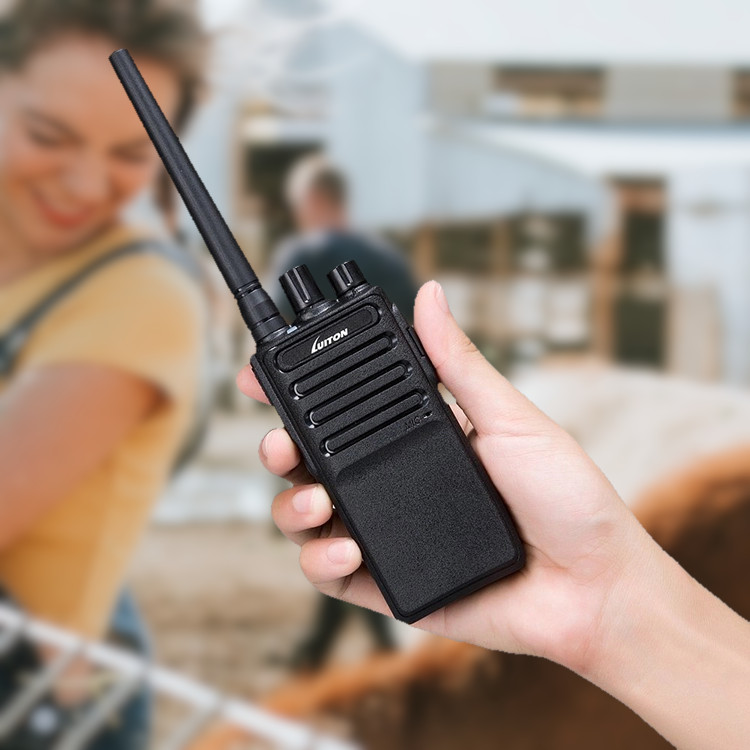This post is also available in:
 English
English  Italiano (Italian)
Italiano (Italian)  Русский (Russian)
Русский (Russian)
The article deals with the use of two-way radios of the permitted range PMR 446 MHz, their characteristics, and their features. Demonstrated typical samples of walkie-talkies. Answers to the most frequently asked questions are provided:
- What is meant by PMR446?
- What are the PMR frequencies?
- What is the power of PMR radios?
- What is a Table (grid) of frequencies?
- Why is a frequency grid required? Why can’t frequencies be used directly?
- How to use the frequency table?
- What are CTCSS and DCS encodings and what is it used for?
- Are the PMR446 radios compatible with other civilian radios (CB radio)?
- What is the typical range of walkie-talkies in the 433 MHz LPD or 446 MHz PMR band?
- How can I increase the communication range in the LPD 433 MHz or PMR 446 MHz band?
- Do walkie-talkies LPD 433 MHz and PMR 446 MHz work indoors?
- Is it better to be indoors or outdoors to achieve maximum communication range?
- Why can I read (listen to) others, but no one hears me?
- Can PMR 446 MHz walkie-talkies be used as a base (dispatch, control room) radio?
- Where can I buy high-quality and inexpensive walkie-talkies in the PMR446 range?
Walkie-talkies PMR-446: purpose, use without a license.
In most countries of the European Union, PMR446 (Private Mobile Radio, 446 MHz) is an unlicensed frequency band in the wider UHF band (UHF band 400-470 MHz, with a wavelength of about 70 cm), which is available for both business and personal free use.
The equipment ranges from consumer to professional-grade walkie-talkies (like those used for FRS, GMRS, and LPD in the US, Canada, and elsewhere around the world). Manufacturers frequently just program different frequencies into the same radio model for sale in different countries. As a result, before purchasing (particularly from abroad), ensure that the transceiver model has the correct version (adapted for use in your country or region). Otherwise, it is possible that walkie-talkies with identical appearances are incompatible with one another because they were manufactured for different locations.
Initially, PMR446 radios had only 8 channels and could operate in analog mode (frequency modulation, FM) in the band of 446.0 – 446.1 MHz. Currently, 16 channels can be used in the 446.0 – 446.2 MHz band, both in analog FM mode and in digital mode (dPMR446, DMR Tier 1).
For use without a license, the output power of the PMR walkie-talkie transmitters is limited to 0.5 watts (0.5 W).
Typically, the PMR446 radio is used for both personal and professional purposes. Radio amateurs and radio enthusiasts often use PMR as a license-free experimental band. PMR radios are often used by hikers, mountain hikers, climbers, hunters, and fans of military and sports games. Different city services (transport, utilities, taxis, construction and maintenance, road services, security and safety, construction and installation) most frequently employ PMR/UHF radios. Additionally, PMR radios are frequently utilized in warehouses and commerce.
The PMR446 radio communication is completely autonomous, therefore it is popular among “preppers” and “survivalists”. Perhaps having a simple, reliable, and universal walkie-talkie like the Luiton LT-458 PRO in the “emergency suitcase” or “survival kit bag” is a good idea.
The best examples of PMR 446 MHz radios
Most PMR446 walkie-talkies look and function similarly. These radios are typically manufactured in China and sold under different brand names such as Retevis, Midland, Baofeng, Motorola, Radioddity, and others. As a rule, this is a compact device with a small display and a few buttons. The buttons allow you to select an operating channel (see frequency grid) and adjust the volume. Typically, these walkie-talkies are powered by normal AAA or AA batteries. Unfortunately, we cannot recommend such gadgets for professional use, because they have a flimsy plastic case and a display that is easy to break. Yet, such walkie-talkies can be used for a variety of purposes, including games and occasional outings.
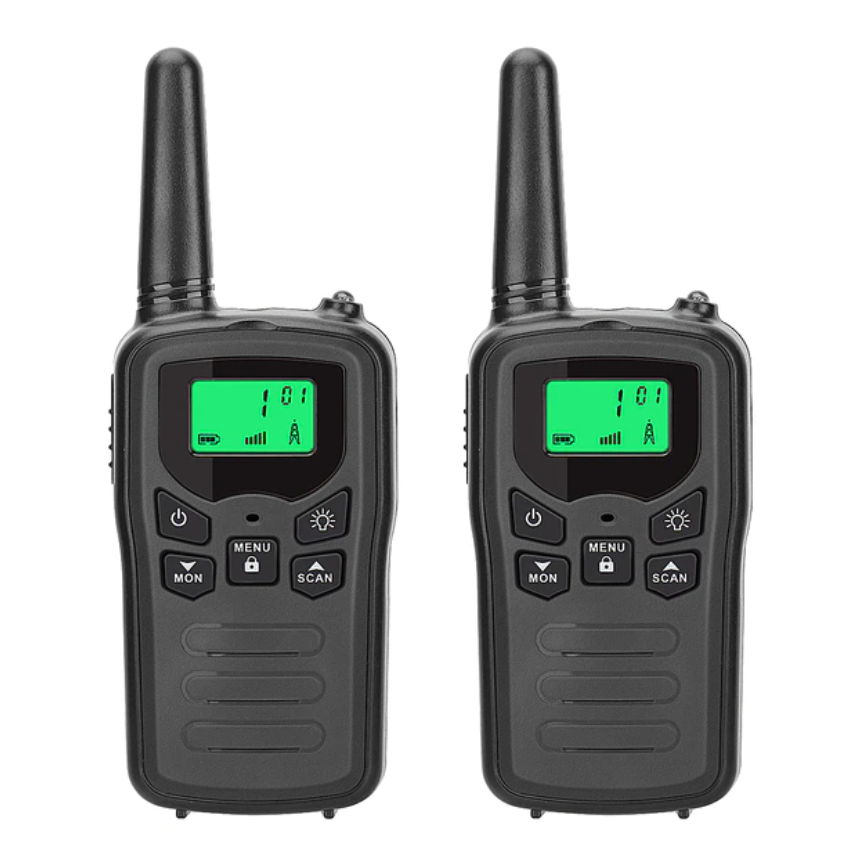
Walkie-talkies in the form factor of professional radios but converted to work in the unlicensed PMR446 band are far more practical. Modern radio circuits are securely protected in a die-cast aluminum chassis and an impact-resistant polycarbonate enclosure in such devices. The display is frequently absent. A mechanical selector (“valcoder”) is used to pick channels. All of this makes the device considerably more dependable and simple to use.
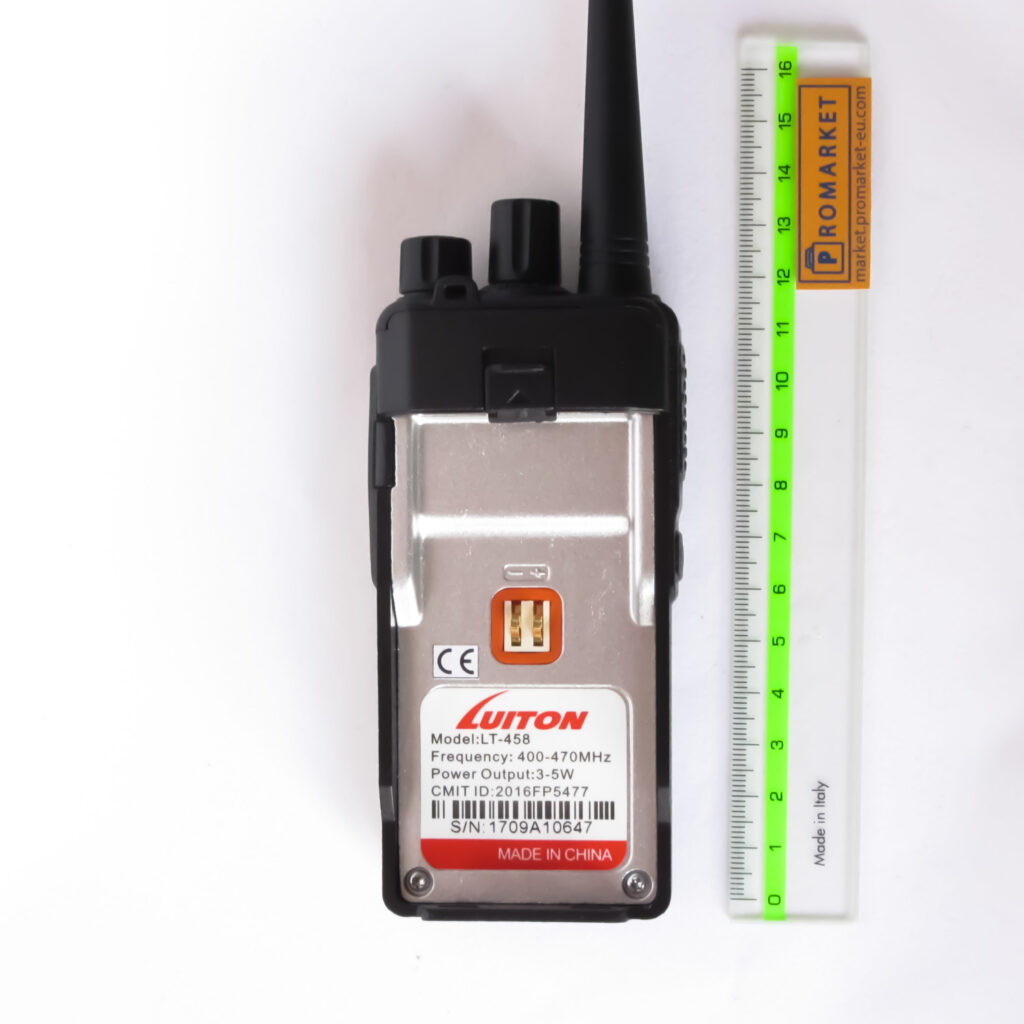
An excellent example of such a device is the Luiton LT-458 compact PMR 446 two-way radio. At a modest price of fewer than 50 euros per pair, this walkie-talkie has all the attributes and advantages of a professional transceiver:
✔ Li-Ion 1500 mAh battery, belt clip, hand strap, and charger already included;
✔ TOT (TX Wait Timer), Busy Channel Lockout, VOX with adjustable sensitivity, Squelch – Noise Limiter, Voice Prompts (CH, EN);
✔ Wide / narrow modulation range selection, DCS/CTCSS codes programming, scanning, battery saving, low battery alert;
✔ Standard 2-pin Kenwood connector for an external headset or PTT, with the ability to connect a programmer;
✔ “Monitor” button for receiving weak or coded signals;
✔ Universal charger: 220 V charger for radio or separate battery (professional desktop type); optional 5V micro-USB charger socket built into the radio.
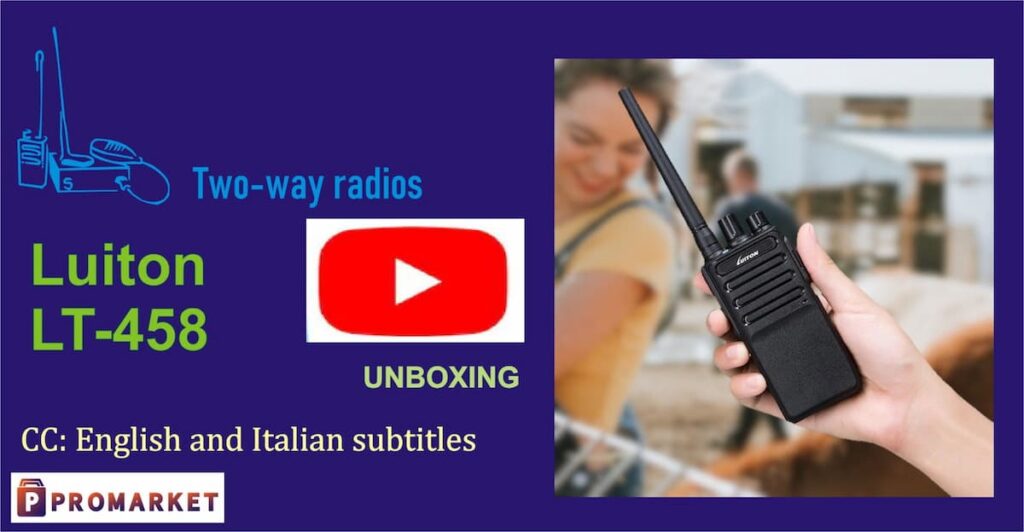
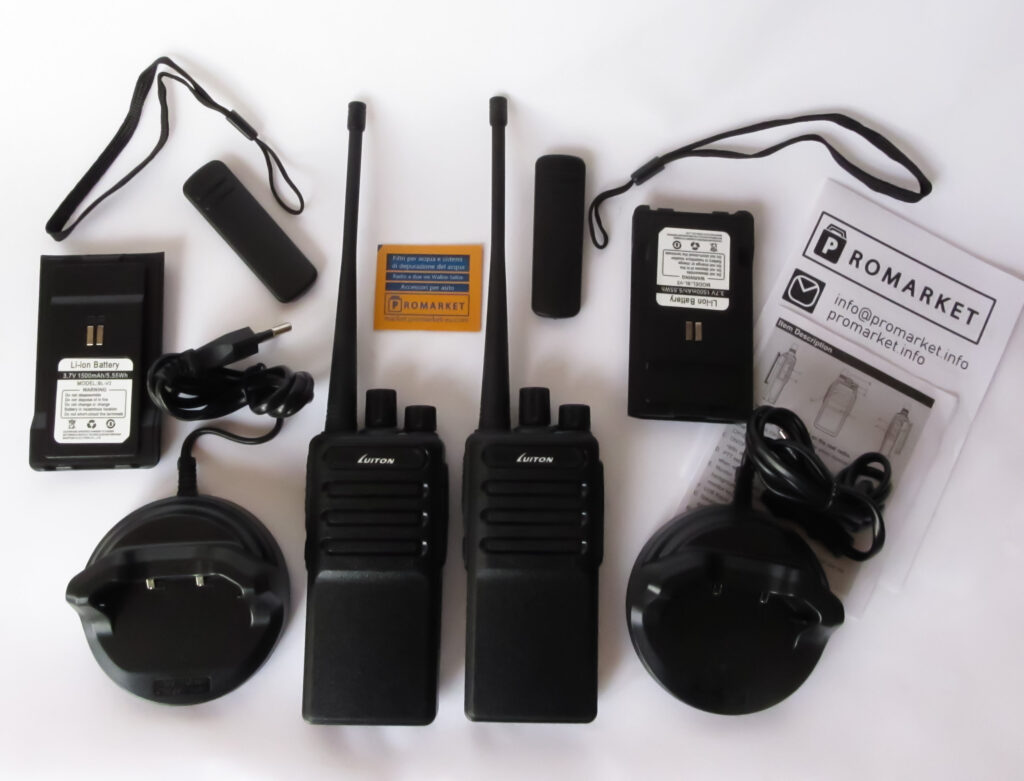
Luiton LT 458 is available in two versions:
The standard version of the Luiton LT-458 will suit most typical applications. The radio is already programmed for all 16 authorized channels in the PMR 446 band.
The Luiton LT-458 PRO version (special edition) includes all of the benefits of the standard model, as well as several unique features:
? The radio power on several channels (see frequency grid) has been adjusted to HIGH, allowing you to increase the operational range (coverage). On other channels, the radio power is set to LOW to extend battery life under normal conditions;
? Channels 9-12 are programmed with CTCSS and DCS coding (see frequency grid), which allows you to get rid of the major interference;
? We double-checked all the characteristics of the walkie-talkies with devices and can guarantee their perfect compliance.
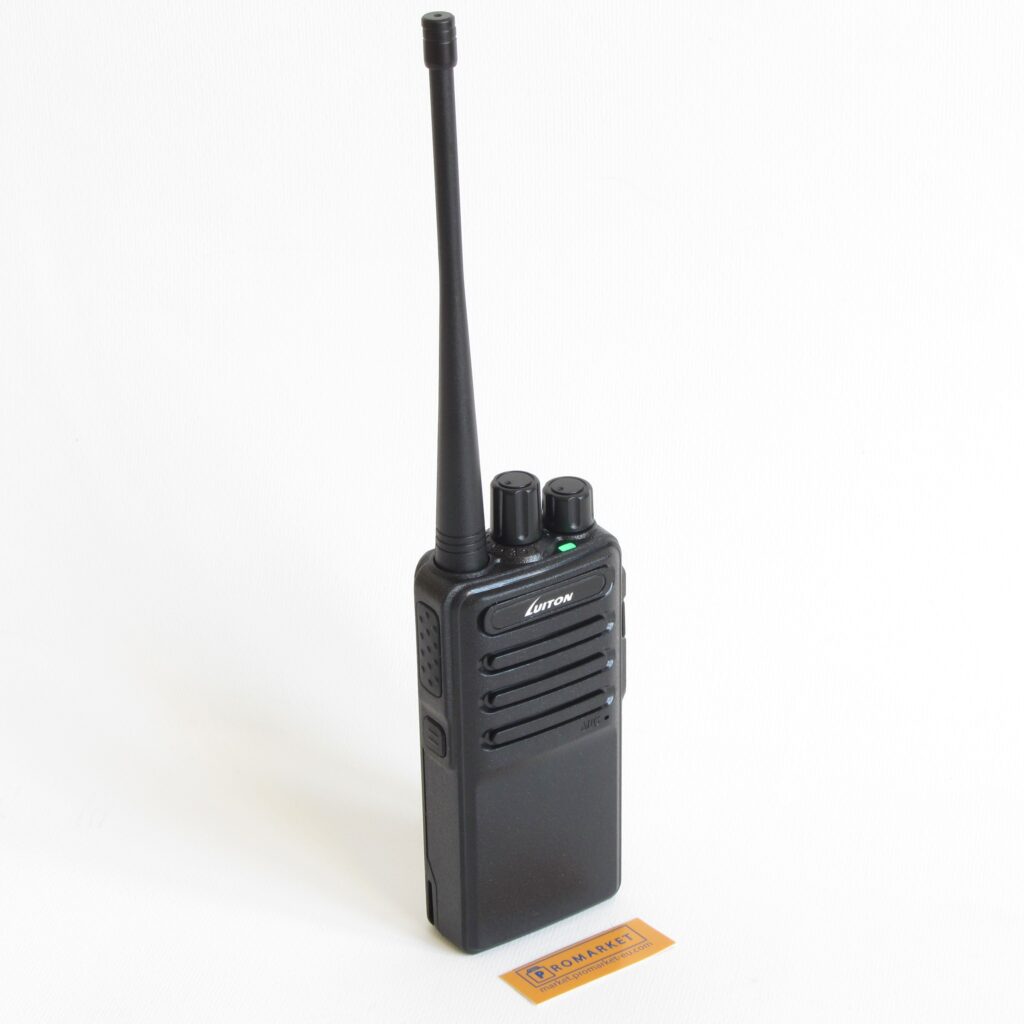

Furthermore, for those who do not mind saving money, ProMarket-EU offers cheaper products with minor packing damage: 100% brand new radios that have been serviceability tested.
We recommend the Luiton LT-458 walkie-talkies because they are straightforward, dependable, and simple to use for both routine work and emergencies. The review has additional information about this radio.
Particular qualities of radio broadcasting in the PMR 446 MHz band
Unlike the other popular CB 27 MHz civilian band, UHF radio waves do not have the effect of reflection from the troposphere and the effect of bending around the earth’s surface. Therefore, the maximum transmission range between PMR446 radios is theoretically limited by the geographical horizon (about 70 km, in line of sight, in the most ideal conditions, between stationary radios). In practice, the typical communication range between portable radios is 1-10 km, and between powerful car radios – is from 5 to 40 km. However, UHF frequencies (band 400-470 MHz, wavelength roughly 70 cm) perform considerably better in buildings (due to good penetration through walls) and when the radios are surrounded by high-rise buildings (due to partial reflection of the signal from the structures of the upper floors). Furthermore, under certain conditions, UHF waves reflect well from rocks.
As a result, the PMR / UHF radios are the most commonly utilized by metropolitan services (transport, utilities, taxis, construction and maintenance, and road services).
Table (grid) of frequencies for civilian radios PMR 446 MHz.
PMR446 analog (FM) and digital TDMA (DMR) channels
Channel Spacing 12,5 kHz
| Channels | Frequencies (MHz) | Common (non-exclusive) use |
| 1 | 446,00625 | Canale Monitor Nazionale (Italia)
FM: CNSAV (Canale Nazionale segnalazione e allarmi
viabilità) 1/4 (CTCSS 77 Hz); FM: Emergency communication (1/12); FM: Trucker (1/9); FM: Baby monitor (1/0); FM: Children’s channel (1/10) |
| 2 | 446,01875 | FM: Prepper (Italia) Canale monitor RRP
– Rete Radio Prepper; FM: Geocaching; FM: Camping; FM: Mountain (German-speaking countries) |
| 3 | 446,03125 | FM: Prepper / Survival (Primario –
Internazionale); FM: Prepper Channel (3/1), in disasters; FM: Mountain (Poland) (3/14) |
| 4 | 446,04375 | FM: Piloti di droni; FM: Drone-Pilot Intercom (4/14); FM: 4WD (4/4); FM: Boat (4/16) |
| 5 | 446,05625 | FM: Scouts |
| 6 | 446,06875 | FM: Event Channel; FM: Hunters (6/12); FM: Free Radio Network (6/20) |
| 7 | 446,08125 | FM: sota446italia 7-7 (Canale 7 con CTCSS 7 = 85.4 Hz)
(Italia); FM: AlpiRadio 7-7 (Canale 7 con CTCSS 7 = 85.4 Hz) (Italia); FM: Mountain (7/7) – Mountaineers in Spain propose using channel 7 subtone 7 for mountain safety |
| 8 | 446,09375 | FM: Canale di Chiamata Generale – General
Call (Europa); FM: Sicurezza in montagna (con CTCSS 114,8 Hz) ⇒ 8/16 (Rete Radio Montana); FM: RK – Radio Kolbe 8-14 (8 con CTCSS 107,2 Hz) (Internazionale); FM: DX & Calling Channel (8/8) FM: Distress (8/18); FM: Mountain – Hill Walking Radio Network (Ireland) (8); FM: Mountain (Italy) (8/16) |
| 9 | 446,10625 | DMR: Digital Calling Channel (CC1 TG99) DMR: Distress (CC1 TG9112), EmCOMM other channel with same TG |
| 10 | 446,11875 | |
| 11 | 446,13125 | |
| 12 | 446,14375 | |
| 13 | 446,15625 | |
| 14 | 446,16875 | |
| 15 | 446,18125 | |
| 16 | 446,19375 | FM: Rete costiera, laghi e fiumi (Tono 16 -> 114.8 Hz) => Gruppo PMR 16-16 (Italy) |
PMR446 digital channels FDMA (dPMR)
Channel Spacing 6,25 kHz
| Channels | Frequencies (MHz) | Common (non-exclusive) use |
| 1 | 446,003125 | |
| 2 | 446,009375 | |
| 3 | 446,015625 | |
| 4 | 446,021875 | |
| 5 | 446,028125 | Scouts => CC1 TG907 TS1 |
| 6 | 446,034375 | |
| 7 | 446,040625 | |
| 8 | 446,046875 | |
| 9 | 446,053125 | Chiamata generale (General Call) ⇒ CC1 TG99
TS1. Sicurezza ed emergenza (EmCom)⇒ CC1 TG9112 TS1 ⇒ MayDay CC1 All Call TS1 |
| 10 | 446,059375 | |
| 11 | 446,065625 | |
| 12 | 446,071875 | |
| 13 | 446,078125 | |
| 14 | 446,084375 | |
| 15 | 446,090625 | |
| 16 | 446,096875 | |
| 17 | 446,103125 | |
| 18 | 446,109375 | |
| 19 | 446,115625 | dPMR => Chiamata generale (General
Call) ⇒ CC1 TG99 dPMR => Sicurezza ed emergenza (EmCom) ⇒ CC1 TG9112 ⇒ MayDay CC1 All Call |
| 20 | 446,121875 | |
| 21 | 446,128125 | |
| 22 | 446,134375 | |
| 23 | 446,140625 | |
| 24 | 446,146875 | |
| 25 | 446,153125 | |
| 26 | 446,159375 | |
| 27 | 446,165625 | |
| 28 | 446,171875 | |
| 29 | 446,178125 | |
| 30 | 446,184375 | |
| 31 | 446,190625 | |
| 32 | 446,196875 |
Notes and explanations:
1. Most countries have approved a civilian PMR446 frequency plan containing 16 standard analog channels numbered 1 to 16 or 32 FDMA (dPMR) channels numbered 1 to 32.
2. To reduce interference in the analog FM mode, sub-tone coding (CTCSS) or (sometimes) DCS is often used. In this case, in addition to the channel number or frequency, the code number or code frequency is indicated. Example: 7/7 or 7-7 or 7/85.4 is the short record for channel number 7 with sub-tone code 7 (CTCSS 85.4 Hz).
Frequently Asked Questions (FAQ) about PMR446 radios:
What exactly does PMR446 mean?
PMR446 (Private Mobile Radio, 446 MHz) is an unlicensed frequency band in the wider UHF band (UHF band 400-470 MHz, with a wavelength of roughly 70 cm) that is available for both business and personal use in most European countries. These frequencies are free to use. Normally, no special approval is necessary. It is sufficient to purchase a walkie-talkie (or more) capable of operating in this frequency band (446.00625 MHz - 446.19375 MHz).
What are the PMR frequencies?
For free use of PMR-446 radios, a frequency range of 446.0 - 446.2 MHz is allocated. This band contains 16 channels in 12.5 MHz steps (center frequencies 446.00625 - 446.19375 MHz, used in analog FM mode or digital TDMA / DMR mode), or contains 32 channels in 6.25 MHz steps (center frequencies 446.003125 - 446.196875 MHz, used in FDMA/dPMR digital mode).
What is a Table (grid) of frequencies?
The table (grid) of frequencies (Frequency Chart, Table) is a table of exact correspondence of a certain frequency to the conditional channel number of a standard frequency grid.
What is the purpose of a frequency grid? Why aren't frequencies used directly?
You can use frequencies, but this is quite inconvenient because you need to remember 5-6 characters for each frequency. In addition, to increase reliability, many walkie-talkies lack a display and extra buttons. As a result, channels - conditional one-two-digit numbers - are utilized in civilian PMR walkie-talkies. They are simpler to recall and set.
And vice versa - there are walkie-talkies that operate in frequency indication mode (VFO); to tune them to a specific PMR channel, it's easy to identify the relevant frequency from the frequency table.
How to use the frequency table?
To use a simple (one-dimensional) frequency table, it is enough to match the channel number and frequency. For example, emergency channel 1 in the PMR446 band corresponds to the frequency 446.00625 - see table 1.
What are CTCSS and DCS encoding and what is it used for?
To reduce radio interference in the analog FM mode, sub-tone coding (CTCSS) or, less commonly, DCS is often used. In this case, in addition to the channel number or frequency, the code number or code frequency is indicated. Example: 7/7 or 7-7 or 7/85.4 is short for channel number 7 with sub-tone code 7 (CTCSS 85.4 Hz).
Attention! If no receive code is set on the walkie-talkie, it hears everyone who transmits on that channel (it doesn't matter if the code is set on their walkie-talkies). If the radio is set to a receive code, it will only hear those who transmit on that channel with that code set to transmit. If no code for transmission is set in the radio, only those radios in which no code for reception is set (working on an "open" channel) will hear it.
Are the PMR446 radios compatible with other civilian radios (citizen band, CB radio)?
The term "CB Radio" or "Citizen Band" usually refers to transceivers that can be freely used on certain frequency bands without obtaining an amateur or professional radio license (permit).
Initially, CB was the 460-470 MHz band of the wider UHF band. Then, at different times and in different countries, new allowed frequency bands appeared: in the ranges of 27 MHz (CB 27 MHz), 43 MHz (CB Low Band), 433 MHz (CB LPD), 446 MHz (CB PMR446), etc..
For technical and legal reasons, devices of different frequencies are usually not compatible with each other. Therefore, it is always indicated which frequency range is assumed.
The Luiton LT-458 radio, made for Europe, operates in the PMR446 frequency band allowed in Europe (16 channels in the range 446.00625 MHz - 446.19375 MHz). Therefore, this radio is compatible (on all channels or partially) with other radios of the same standard.
What is the typical work distance (range, radius) of walkie-talkies in the 433 MHz LPD or 446 MHz PMR band?
The range of the PMR-446 can vary from a few hundred meters (in the city) to several kilometers (in the countryside) or many kilometers from high ground, depending on the surrounding topography. It is believed that the maximum range is theoretically limited by the geographic horizon (about 70 km, in line of sight). In practice, the typical communication range between portable radios is 1-10 km, and between powerful car radios - is from 5 to 40 km.
The communication range inside buildings depends on the material of the walls. As a rule, the most powerful walkie-talkies are able to "pierce" several reinforced concrete floors or load-bearing walls made of concrete or brick.
How can I increase the communication range in the LPD 433 MHz or PMR 446 MHz band?
There are four ways to increase the communication range:
1) Use a high-gain antenna (affects both reception and transmission);
2) Increase transmitter power (affects transmission only);
3) Raise the antenna higher above the ground (affects both reception and transmission);
4) Apply a special relay (for example, using the Internet: https://ruspo.com/relay1en.htm).
For example, according to the approximate formula, the signal transmission range can be increased by 2 times by raising the antenna 4 times higher or by increasing the transmitter power by 16 times.
Do the LPD 433 MHz and PMR 446 MHz radios work indoors?
Walkie-talkies of the LPD 433 MHz and PMR 446 MHz bands work well in enclosed spaces. The communication range inside buildings depends on the material of the walls. As a rule, any walls of a building weaken the radio signal. Reinforced concrete and metallic materials attenuate the signal more. Ceramics (brick, tile, shingle) attenuates the signal less. Wood weakens the radio signal even less. As a rule, the most powerful walkie-talkies are able to "pierce" several reinforced concrete floors or load-bearing walls made of concrete or brick.
Is it better to be indoors or outdoors to achieve maximum communication range?
To achieve the maximum radio range (when talking about a walkie-talkie) it is always better to be outdoors, as high as possible, and to have, if possible, a direct line of sight in the direction of interest. Using a handheld (portable) walkie-talkie with a built-in antenna, if you're facing a window, the signal goes out fairly well in the direction you're looking. It is better if the window has wooden or plastic frames and a size of at least 70 cm (taking into account the wavelength of the UHF decimeter range 446 MHz).
To ensure comfortable operation of the radio from the premises, remote roof antennas (stationary or car) are used, which are connected to the antenna socket of the radio using a low-attenuation cable. Of course, such an antenna must be designed for the range of the radio and tuned to a specific operating frequency in resonance.
Why can I "read" (listen) others well, but no one hears me?
Radio communication is not always "symmetrical", even if the two-way radios are tuned to the same frequency (channel). If you hear another radio, but the other does not receive you, there may be several reasons:
1) walkie-talkies have different transmission power: the signal of a more powerful walkie-talkie extends over a greater distance;
2) another walkie-talkie is situated next to the source of interference (computer, LED lamp, power line) - in this case, there is an interference that limits reception, but everything is OK with the transmission;
3) another radio has the same frequency, but CTCSS or DTS encoding is programmed into it - in this case, this radio will receive a signal only with this encoding (even nearby), but everyone will hear its broadcast (even those who have not programmed any encoding). It is usually possible to reprogram encodings, but sometimes this requires a special device (USB programmer) and software.
Can PMR 446 MHz walkie-talkies be used as a base (dispatch) radio?
Yes, PMR446 MHz walkie-talkies can be used as a base (dispatch) radio. However, when used from inside a building with the original connected (or built-in) antenna), the communication range will not be large. If you need to increase the communication range, you should use remote (rooftop, stationary) antennas with high gain.
In theory, any transceiver can be connected to a longer antenna (having more gain) or to a distant rooftop antenna (having more gain and higher height). This usually dramatically increases the broadcast area. Of course, the antenna must have adequate wave resistance (50 ohms) and a resonant frequency that matches the frequency of the transmitter (in the case of the LT-458 radio, this frequency is 446 MHz). However, in Europe, this is only officially allowed for users who have an amateur (HAM) or professional radio license.
Where can I buy high-quality and inexpensive walkie-talkies in the PMR446 range?
You can buy walkie-talkies, antennas and related products in the ProMarket-EU online store.
Delivery to all EU countries.
The ProMarket online store is open for clarifications and additional information. Requests can be sent by e-mail and through a special web form.
This post is also available in:
 English
English  Italiano (Italian)
Italiano (Italian)  Русский (Russian)
Русский (Russian)

